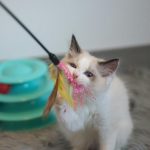Has your beloved feline friend been diagnosed with vision impairment? If so, it’s understandable that you might be overwhelmed and worried about how you can adapt their environment at home to keep them safe and comfortable. Vision impairment in cats can occur due to a variety of reasons, such as aging, injury, or disease. While this change can be challenging for both you and your pet, there are numerous adjustments you can make to ensure your four-legged friend can continue to live a fulfilling and happy life.
Understanding Your Cat’s Needs
First and foremost, it’s important to understand the unique needs of a visually impaired cat. Unlike humans, cats do not rely solely on their sight. They also use their acute sense of smell and hearing to navigate their environment. If your cat is losing their vision or is already blind, they are likely to rely even more on these other senses.
A lire aussi : What are the signs of cognitive decline in elderly cats and how can you create a supportive environment for them?
When your cat’s vision starts to fail, they might feel more anxious and confused about their surroundings. It’s essential to keep an eye on their behavior and make them feel as secure and comfortable as possible. In this regard, making your home safe and predictable for your cat is of utmost importance.
Modifying Your Pet’s Environment
As your cat’s primary caregiver, it’s up to you to create a supportive environment that can help your cat adapt to their vision loss. This involves rearranging your home to minimize potential hazards and making necessary adjustments to help your pet move around comfortably.
Cela peut vous intéresser : How do you provide post-operative care for a cat that has undergone dental surgery to ensure recovery?
Start by clearing the floor and keeping it clutter-free. Remove any objects that could pose a threat to your cat and ensure there are clear paths for them to move around. Avoid moving furniture around as cats memorize the layout of their space and any changes can cause them confusion and stress.
Moreover, cats are natural climbers. If your cat enjoys climbing onto high surfaces, consider providing them with a cat tree or steps that are easy to navigate. This can prevent them from attempting to jump onto surfaces that could be dangerous.
Nutritional Care and Hydration
Your cat’s diet and hydration play a pivotal role in their overall health and wellbeing. Providing the right food and ensuring they drink enough water is even more crucial when they are coping with vision loss.
Include high-quality, nutrient-rich food in your cat’s diet. Meals should be served in a consistent place and time, so your cat knows where and when to expect their food. It’s also a good idea to use a water fountain for cats which can stimulate their interest in drinking water. The sound of flowing water can help your blind cat locate their water source easily.
Creating a Safe Outdoor Space
If your cat is accustomed to spending time outdoors, you might have concerns about their safety after their vision loss. You can create a safe outdoor environment for your cat by fencing off a specific area in your backyard. This will give them the freedom to explore without risking their safety.
Ensure you keep the outdoor area free from hazards such as poisonous plants or sharp objects. Provide them with a sheltered area where they can rest and hide if they feel anxious. It’s also crucial to supervise your cat when they are outdoors to ensure they don’t wander off and get into dangerous situations.
Regular Check-ups and Veterinary Care
Regular check-ups and veterinary care are crucial for maintaining your cat’s health, especially when they are dealing with vision impairment. Regular visits to the vet will ensure early detection of any potential health issues and provide necessary treatments promptly.
If your cat’s vision loss is due to an underlying health condition, your vet will be able to provide appropriate treatment options. It’s also essential to keep a close watch on your cat’s behavior and report any changes to your vet immediately.
Remember, caring for a visually impaired cat can be challenging, but with love, patience, and understanding, you can help your pet lead a comfortable and happy life. Providing a safe, nurturing environment is the best thing you can do for your furry friend. Through your steadfast effort and commitment, you can let your cat know that they are still loved and cherished, no matter what changes they may be going through.
Sensory Stimulation and Interactive Toys
To make your visually impaired cat feel comfortable and secure, consider incorporating sensory stimulants into their environment. Sensory stimulation helps blind cats to stay active and reduces the chances of them becoming depressed or anxious.
Remember, just because your cat has lost their sight, it doesn’t mean they can’t play or interact with their environment. Use toys that make noise, like bells or crinkles – these will help your cat locate the toy and engage with it. Toys with different textures can also provide tactile stimulation.
If your cat enjoys catnip, incorporate it into their playtime. Catnip toys can stimulate their olfactory sense, keeping them engaged and entertained. Interactive feeders can also be useful in keeping your pet physically and mentally active.
While choosing toys for your blind cat, avoid toys with sharp edges or small parts that could pose a choking hazard. Also remember to always supervise playtime, especially during the initial adjustment period.
Litter Box and Scratching Post Accessibility
Maintaining proper hygiene is also crucial for your visually impaired cat. This is where the litter box comes in. Ensure that you keep the litter box in a consistent location so your blind cat can easily find it. You might need to guide your cat to the litter box initially until they can locate it on their own.
Just like the litter box, scratching posts play a fundamental role in your cat’s life. Scratching is a natural behavior for cats, and it helps them stretch their muscles, mark their territory, and manage stress. Ensure that scratching posts are easily accessible and safe for your cat to use.
Conclusion
Although caring for a visually impaired cat may seem daunting initially, remember that cats are resilient creatures. With a bit of patience, understanding, and some simple modifications to their environment, your cat can lead a quality life filled with love and happiness.
Stay consistent with your cat’s daily routine and provide them with the necessary veterinary care. A stable environment, coupled with regular check-ups with your veterinarian, will help to maintain your pet’s health and wellbeing.
Remember, your cat’s loss of vision doesn’t change the fact that they are still the same loving, intelligent, and endearing pet that they’ve always been. Your unwavering effort and dedication can help your blind cat lead a fulfilling life. After all, every cat, regardless of their age, health status, or physical abilities, deserves a comfortable, safe, and happy home.














